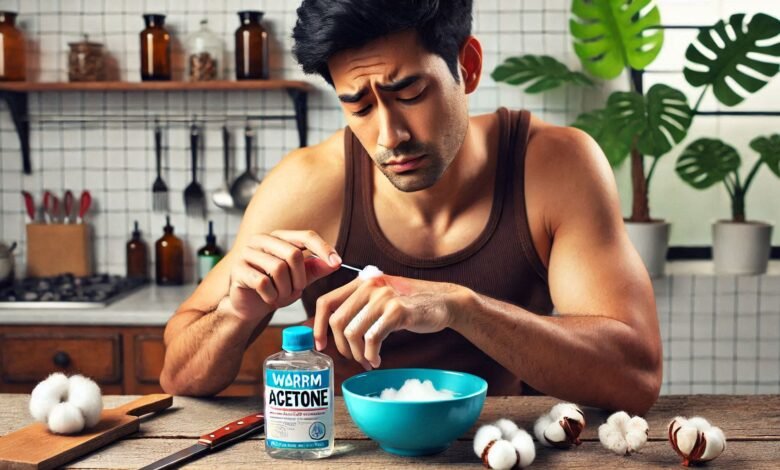
Super glue is a fantastic tool for quick fixes and DIY projects. However, its powerful adhesive properties can become a problem if it accidentally gets on your skin. If you’ve found yourself in a sticky situation, don’t panic! This guide will walk you through everything you need to know about safely removing superglue from your skin, avoiding common mistakes, and preventing future accidents.
Understanding SuperGlue and Its Effects on Skin
Superglue, also known as cyanoacrylate adhesive, is a fast-acting adhesive used for bonding various materials. Its quick-drying properties make it a household favorite, but these same qualities can pose challenges when it comes into contact with skin.
How Super Glue Bonds to Skin
When super glue touches your skin, it reacts with moisture, creating a strong bond almost instantly. This can lead to:
- Irritation or discomfort: The adhesive can cause a burning sensation or minor redness on sensitive skin.
- Unintentional bonding of skin surfaces: Fingers or other skin areas can become stuck together, making movement difficult.
- Potential allergic reactions: Some individuals may experience itching, swelling, or hives due to sensitivity to cyanoacrylate.
Knowing how superglue works is the first step in safely removing it from your skin.
Immediate Steps to Take When SuperGlue Gets on Your Skin

If super glue gets on your skin, acting quickly but carefully is essential. Follow these steps:
- Stay Calm:
- Avoid pulling the glued skin apart forcefully, as this can cause tears or injuries. Panicking might lead to hasty actions that worsen the situation.
- Wash with warm, soapy water.
- Fill a bowl with warm water and add a few drops of mild soap.
- Soak the affected area for 10-15 minutes to soften the glue. This is particularly effective for small areas like fingers.
- Gently rub the area with your fingers or a soft cloth to loosen the adhesive. Repeat if necessary.
- Use Acetone-Based Nail Polish Remover:
- If soapy water isn’t effective, acetone can help dissolve the glue. However, it should be used with caution.
- Apply a small amount of acetone-based nail polish remover to a cotton ball or swab.
- Dab it gently on the glue until it starts to dissolve. Do not soak your skin in acetone, as prolonged exposure can cause dryness and irritation.
- Rinse thoroughly with water afterward to remove any residue.
- Moisturize:
- After removing the glue, apply a moisturizer or petroleum jelly to soothe the skin and restore moisture lost due to acetone or prolonged soaking.
Also Read: Top Collagen Health Benefits for Men
How to Safely Remove Superglue from Different Skin Areas
Different areas of the body may require tailored approaches for safe glue removal. Here’s how to handle specific situations:
Fingers and Hands
- Warm Soapy Water: Soak your hands in warm, soapy water for 10-15 minutes. This will help loosen the bond.
- Peeling: Gently peel apart the glued skin, avoiding any sudden or forceful movements.
- Buffing: Use an emery board or pumice stone to carefully buff away any residual glue, being cautious not to irritate the skin.
Sensitive Areas (Face, Lips, Eyes)
- Face:
- Avoid using acetone on the face, as it can cause irritation. Instead, apply petroleum jelly or coconut oil to soften the glue.
- Gently massage the area in circular motions until the glue begins to loosen.
- Lips:
- If your lips are glued together, do not try to pull them apart forcefully.
- Apply warm water with a soft cloth and gently roll your lips to loosen the bond. Petroleum jelly can also help.
- Eyes:
- If glue enters the eye area, seek immediate medical attention. Do not attempt to remove it yourself, as this can cause further damage.
Large Skin Surfaces
- Use oil-based products like coconut oil, olive oil, or baby oil to break down the adhesive.
- Gently massage the oil into the affected area to loosen the glue. If the glue persists, consult a healthcare professional.
What to Avoid When Removing Super Glue
Mistakes during glue removal can worsen the situation. Avoid these common errors:
- Using Sharp Objects:
- Never scrape the glue off with knives, scissors, or other sharp tools, as this can cut or damage the skin.
- Applying Excessive Force:
- Pulling or peeling glued skin apart with force can cause painful tears or injuries.
- Using Non-Skin-Safe Chemicals:
- Industrial solvents or harsh chemicals can irritate or burn the skin. Stick to skin-safe options like acetone or oils.
When to Seek Medical Help
While most superglue incidents can be resolved at home, some situations require professional assistance. Seek medical help if:
- Severe Skin Irritation:
- Signs include redness, swelling, blistering, or a burning sensation that persists after glue removal.
- Sensitive Areas:
- If glue is in your eyes, lips, or other sensitive areas and cannot be safely removed at home.
- Persistent Adhesion:
- If the glue bond remains despite multiple safe removal attempts.
Preventing Superglue Accidents in the Future
Prevention is always better than cure. Follow these tips to avoid superglue mishaps:
- Use protective gear:
- Wear gloves or use tools like tweezers to handle super glue, especially during DIY projects.
- Work in a Controlled Environment:
- Avoid working in cluttered or unstable areas where spills are more likely.
- Store Safely:
- Keep super glue out of reach of children and pets, and store it in a cool, dry place to prevent accidental spills.
- Read Instructions:
- Always read the product label for safety guidelines and proper usage instructions.
Frequently Asked Questions About Super Glue on Skin
Can Superglue Damage My Skin Permanently?
In most cases, superglue does not cause permanent damage. However, improper removal techniques, such as using sharp objects or excessive force, can lead to skin tears or scars.
Is Acetone Safe for All Skin Types?
Acetone can dry out the skin and cause irritation, especially for sensitive skin types. Use it sparingly, and always follow up with a moisturizer to prevent dryness.
How Long Does It Take for Super Glue to Naturally Come Off?
If left untreated, superglue will naturally shed as your skin cells renew. This process can take a few days to a week, depending on the amount of glue and your skin’s natural exfoliation rate.
Conclusion
Accidentally getting superglue on your skin can be stressful, but with the right knowledge and techniques, it’s a manageable issue. Remember to act quickly, use safe removal methods, and avoid common mistakes. By following this guide, you can handle any sticky situation with confidence.







